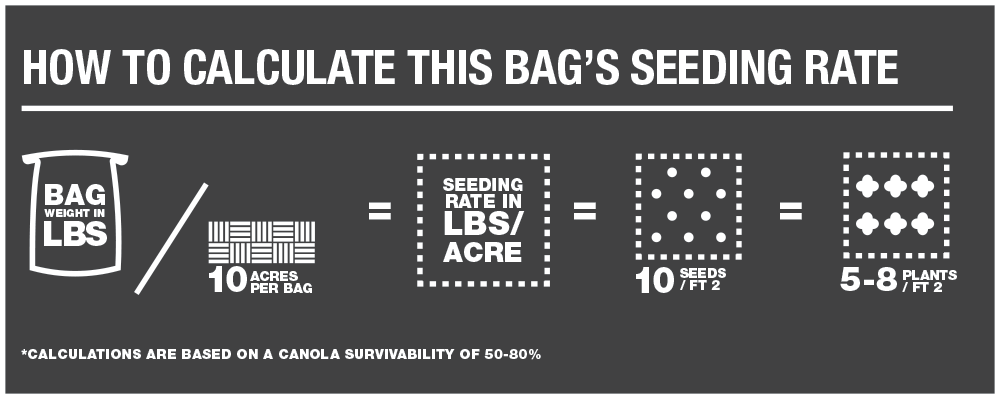Canola Council of Canada1 research has shown that a targeted plant population of 5 to 8 plants/ft21 is the ideal way to maintain an optimal yield. Any less, and you leave your field more vulnerable to weeds. Any more and you risk potential thinner, less productive plants. To put it another way, 5 to 8 plants/ft21 is the perfect way to set your canola crop up for success. DEKALB’s recommended seeding rate is 10 seeds per square foot. With average canola survivability in Western Canada ranging from 50-80%, this seeding rate supports a targeted plant population of 5-8 plants per square foot.
There are risks when managing plant stands with too low and too high plant densities.

RISKS OF LOW PLANT POPULATIONS:
Non-uniform plant stand - this may be affected by the seeding practices or the field variability. A low emergence rate could be the cause of low plant density. In fields that historically have patchy stands, a low seeding rate can compound the issue.
Weed control - low plant densities allow more room for weeds to grow. Vigilant weed management will be important if plant densities are lower.2
Uneven maturity - low plant stands may have increased branching. This can cause delayed maturity since branches flower and mature later than the main stem. In a short growing season, maturity may be an important factor to consider.2
Extended flowering - time due to increased branching in low plant populations can make it difficult to stage and time a proper sclerotinia fungicide application.
RISKS OF HIGH PLANT POPULATIONS:
Lodging - high plant densities (more than 14 plants per square foot) can result in increased lodging as stems are thin and pods may be concentrated at the top of the plant.3
Disease - high plant densities can be more at risk for yield loss due to sclerotinia. A thick canopy and increased lodging can create ideal conditions for this disease.4
Internal crop competition - too many plants condensed in a row can lead to crop competition where plants compete for available resources to the point where some plants are thinned out.
OPTIMAL SEEDING RATES. IT’S NOT ABOUT BAG WEIGHT. IT’S ABOUT PRECISION.

DEKALB has a long history of packaging by seed count with corn and soybeans and now we’re applying the same methods of precision to canola seed. Using their unique ability to accurately measure TSW (thousand seed weight), they can ensure that every bag of DEKALB® canola contains no less than 4.25M seeds - the optimal target plant population for every 10 acres. Just choose the hybrid that’s right for you and you’re on your way to optimizing the performance of your DEKALB canola.
They count the seeds so you can make the seeds count.
PACKAGING
Regardless of TSW every bag of DEKALB canola will have no less than 4.25 million seeds per bag and is recommended to seed at 10 acres per bag. Simply divide the total pounds of the bag by 10 to get your seeding rate. Example: Bag weight is 45 lbs. 45 lbs/10 acres = 4.5 lbs/acre seeding rate.
PLANNING
With every bag equal to 10 acres you can know in advance the exact amount of seed you need for your canola acres. DEKALB canola will be available in:

4.25M seeds/bag. Seeds 10 ac./bag
85M seeds/tote. Seeds 200 ac./tote
170M seeds/SeedPak. Seeds 400 ac./SeedPak